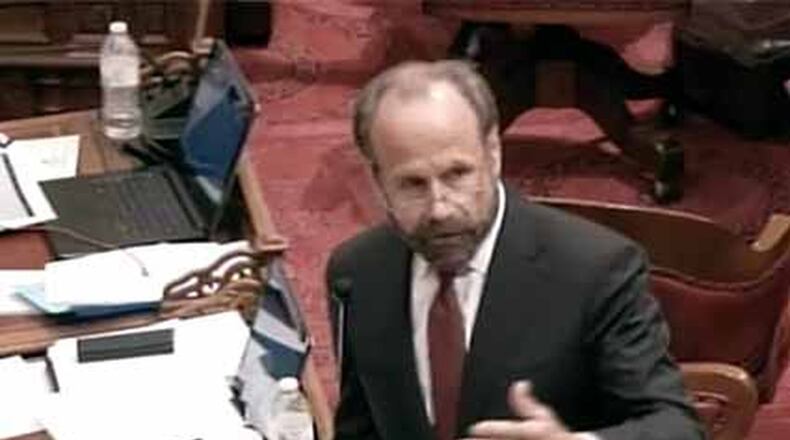Dr. Esmail Nadjmabadi doesn’t have to tell his patients about the time a woman sought treatment for a spider bite behind her left knee and he ended up examining her vagina and anus.
He doesn’t have to acknowledge the way he touched a teenage girl who complained only of a head cold. Or that he propositioned a young woman by assuring her that while he had no sexually transmitted diseases, he did have a lot of money.
Like hundreds, if not thousands, of other physicians across the United States, Nadjmabadi is under no obligation to publicly acknowledge he is still practicing medicine despite being penalized for sexual misconduct.
But in California, where Nadjmabadi practices, lawmakers are trying, for a second time, to remove the shroud that lets doctors hide their transgressions from patients. A state Senate committee in Sacramento released a report last week listing 552 California doctors who are on probation for a wide variety of serious offenses — including 78 who engaged in sexual misconduct with patients.
The report renewed an effort by California State Sen. Jerry Hill to force doctors to reveal their disciplinary history to every patient. Last year, Hill’s first attempt failed under heavy lobbying by California doctors.
Hill's campaign to shine light on physician misconduct was featured in The Atlanta Journal-Constitution's 2016 series about doctors and sex abuse. The newspaper's national investigation identified more than 2,400 doctors who had been disciplined since 1999 for sexual misconduct involving patients. More than half still were licensed to practice, an indication of the deference shown to even the worst sexual predators among the nation's 900,000 physicians.
No state routinely requires doctors to tell patients when they have faced disciplinary action, the newspaper found. The lack of transparency was common: some states post no disciplinary records online, or purge case files after as little as five years, while 21 sometimes handle misconduct cases in secret.
“You’re notified if your car is recalled,” Hill said in a statement last week, “but it’s far from easy – and for some it’s nearly impossible – to find out if your doctor is on probation and the reasons why.
“How are patients supposed to make informed decisions about their health care if they aren’t notified about this critical information?”
In California, home to more than 10 percent of the nation’s doctors, the state medical board has allowed physicians to practice while on probation after prescribing unnecessary narcotics to patients who died of overdoses, implanting expired medical devices into patients to maximize profits, “accidentally” tying women’s fallopian tubes, performing surgery under the influence of drugs or alcohol, and removing a healthy kidney while leaving a diseased one in place.
Nadjmabadi, an internist from Bakersfield, did not respond to a request for an interview. Public records show that he came to the attention of medical regulators after six women reported that he touched them in a sexual manner during examinations in 2005.
A 19-year-old told regulators she saw Nadjmabadi about pain in her right shoulder. During a follow-up exam, she said, he told her he needed to check other joints – and, after instructing her to remove her pants and underwear, touched her buttocks in a sexual manner.
A 23-year-old who went to Nadjmabadi for back pain said the doctor asked her to lower her pants and then yanked down her underwear. When she objected, she said, he told her he was looking for “fun,” had no sexually transmitted diseases and had plenty of money. “I am sorry,” she quoted him as saying, “I am sorry. You are just so beautiful.”
As she tried to leave the examining room, the woman said, the doctor blocked the door and tried to kiss her on the lips.
Nadjmabadi pleaded no contest to a charge of sexual exploitation by a physician in 2009 and received a suspended sentence. The next year, he surrendered his medical license to settle an investigation by the state medical board.
But in 2015, he petitioned the board for reinstatement, noting that he twice had attended professional boundaries courses — once for two days, another time for three — as well as an ethics class. He blamed his misconduct on his immaturity and admitted he had “misread some cues” from female patients.
A psychologist’s report noted that the sexual violations occurred during a stressful period; the doctor’s wife was studying to become a physician’s assistant, and he often was required to care for their school-age daughter.
“He felt powerful and in control only in the context of his medical practice,” the report said. “He was emotionally drained and sexually unfulfilled.”
So the medical board reinstated him, with conditions. He is on probation until 2022 and must have a chaperone present when he examines female patients. But he doesn’t have to disclose anything about his punishment to patients.
Such cases demonstrate the need for greater transparency in the physician disciplinary process, Hill said last week.
“Over 99 percent of doctors are good actors and are improving the quality of life for patients every day,” he said. “As policymakers, we need to determine if it’s appropriate for the doctors on probation to continue practicing and, if so, ensure that patients are notified before their visit.”
About the Author
The Latest
Featured



